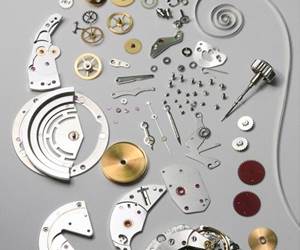Do you take surface plates for granite? (See what I did there?)
There are various reasons why granite is the material of choice for machine bases and metrology components. These include its machinability, inertness, flatness, mobility, rigidity, thermal stability, long-lasting properties, ease of cleaning and vibration and rust resistance. It is also offered in many sizes, along with a range of accessories.

It’s important for manufacturers to work with a reputable supplier to ensure they come away with a precision granite inspection solution for their specific needs. (Photo credits: The L.S. Starrett Co.)
That said, how should manufacturers work with a reputable supplier to ensure they come away with a precision granite inspection solution for their specific needs?
Manufacturing facilities, as well as calibration labs, rely on measurement surfaces to be precise. At a minimum, surface plates should exceed federal specification ASME B89.3.7. Supplier engineers should have completed a stringent training program and also participate in annual proficiency testing in order to consistently produce high-quality products.
A NIST-traceable calibration certificate — supplied with the surface plate — is an important benchmark for quality. And, if required, an A2LA accredited certificate should be issued for any calibrations that are within the ISO/ IEC 17025 scope.
But beyond that, here are four recommended action items from The L.S. Starrett Co. to help ensure the granite surface plate solution you settle on is right for your application:
1) Complete an initial inspection. Before taking ownership of a surface plate, review the final inspection process with your supplier. It is recommended that plates are inspected with an autocollimator or electronic levels and Starrett Repeat-O-Meter gage, which detects local error, not overall flatness. Some suppliers offer surface plates that far exceed what is “required.” For example, black and pink plates might be engineered to support a loading weight of 100 pounds per square foot, loaded in the center of the plate, which is twice that required by federal specification. This means that the designated load may be placed in the center of the plate without deflecting the overall accuracy more than 50%.
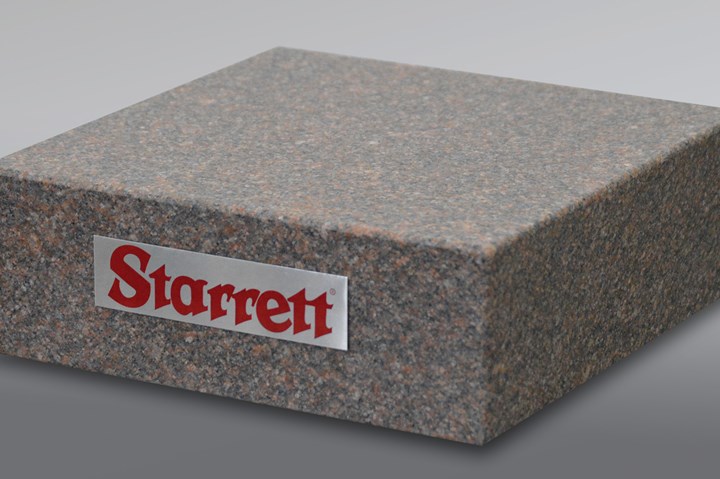
The new Superior Red granite surface plate material from The L.S. Starrett Co. features the highest percentage of quartz of any granite for greater wear resistance, the company says. The new material is said to have a higher density delivering even more stability.
Surface plate flatness is very important. However, repeat reading is as well. The flatness and repeat readings of some of highest-quality plates are unilateral, not bilateral. Unilateral accuracy means that all points on the work surface are contained between two parallel planes separated by a distance greater than the distance specified for each size and grade. Bilateral accuracy means twice (plus or minus the accuracy stated) as much flatness deviation may exist. Value-specified calibration certificates are recommended to be the TIR (total indicator reading).
2) Provide proper surface plate support. To ensure accurate readings, granite surface plates must be properly supported on three or four points as specified in ASME B89.3.7. The standard work height for stands is generally 36 inches, and it is recommended to use floor locks for all castered stands. There are several options for supporting the plate.
Tubular steel surface plate stands are constructed from welded, square-steel tubing for strength and durability. Steel crossbeams are located at the proper support points to ensure maximum surface plate accuracy. Cabinet support stands are built with square-steel tubing and heavy-gauge steel for durability. Drawer stands are available as well.
If using a block and wedge system, a large steel stand to support the granite base is unnecessary. This system comprises three granite blocks cut and honed to provide the desired work height. An adjustable wedge is placed between the top of the block and the bottom of the surface plate. This system provides maximum support with minimal cost. Standard blocks are 12 by 12 inches, with a height based on the thickness of the surface plate.
For maximum life, it is recommended to use a high-quality cover to protect the surface plate when it is not in use and regularly clean the plate with granite surface plate cleaner. Keeping the precision surface plate clean and in the best condition can lengthen your calibration intervals and help ensure that your readings are accurate.
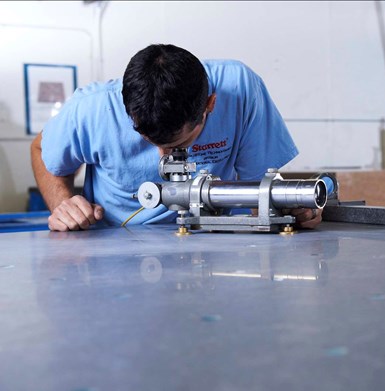
Review the final inspection process with your supplier. It is recommended that plates are inspected with an autocollimator or electronic levels.
3) Perform routine calibration. Once you have the plate in production, it is important to periodically check that your plate is properly calibrated. Federal Spec ASME B89.3.7 dictates the proper methods for determining the overall flatness of a granite surface plate. In section 4.5.9, it states, “A…system of diagonals, perimeter and center lines may be calibrated on plates, and especially on small ones, by using a precision calibrated straight edge, adjustable supports and a suitably mounted indicator…”. This is a basic description of the Starrett Planekator.
A Planekator kit consists of a granite straight edge, a set of supports (one fixed height and one adjustable), a calibrated 0.000020-inch dial indicator with indicator carriage and a storage case. The straight edge is supplied with a correction tape.
When selecting a Planekator, consider the size of the plate(s) you will be inspecting. The straight edge should be at least equal to the full width of the plate and at least equal to 50% of the length of the plate. For example, a 36-inch Planekator straight edge can be used to calibrate any surface up to 36 by 72 inches.
A Repeat-O-Meter can be used to visually scan the work surface of the plate. The range of the indicator readings shall not exceed the values shown in Table II of section 3.3.3 in Federal Specification ASME B89.3.7. The device performs a similar function when a height gage and gage block are used in a calibration process, but is more dependable and easier to use for this application.
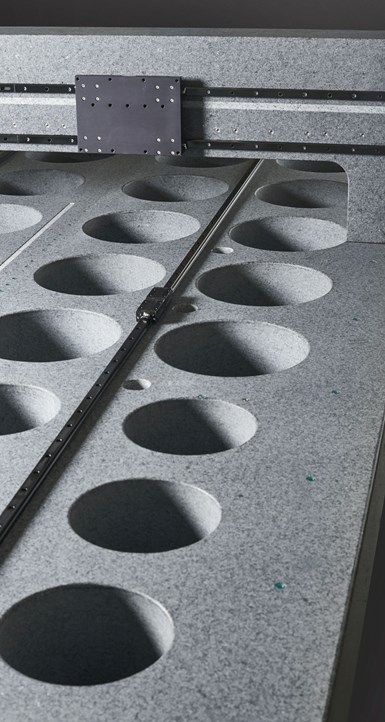
Custom, value-added assembly options for granite surface plates are available using precision steel rails, encoders, ball screws and so on.
In a short amount of time, you can check the repeat measurement accuracy of a surface plate by moving the Repeat-O-Meter over the work surface, noting the full indicator range. In just a few more minutes, by zeroing the device at the center along a diagonal or centerline, and then recording readings at 5-inch intervals, you can chart the readings from the plate. The difference between the greatest plus and minus readings is the maximum measurement error possible on the plate.
Also, calibration and certification services for both surface plates and accessories are helpful to maintain precision by certifying their condition and resurfacing if necessary. If you have old granite products that are in very poor condition, some suppliers can grind and lap your old products, making them appear like new and calibrate them to A2LA (for perpendicularity, parallelism, flatness and repeat reading).
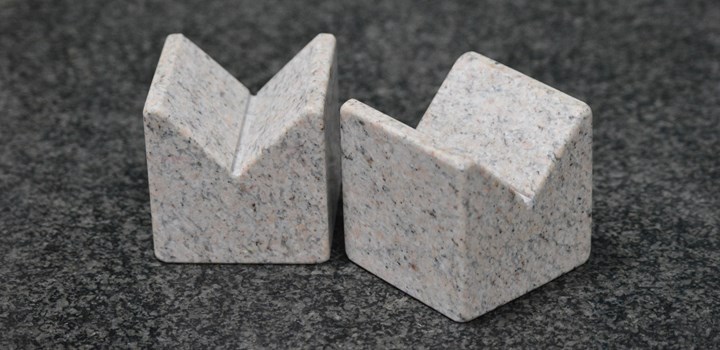
Granite V blocks are a good option for supporting cylindrical pieces during inspection.
4) Consider metrology accessories. Knowing the surface plate accessories that are available will also help you and your supplier create the optimal plate design. Here are some options:
- Master squares. These devices are well suited for inspecting the X, Y and Z axes of machine tools. This product is very stable and rigid, providing considerable squareness references. Master squares have five finished faces (one large face and four edges) finished flat, square and parallel to either laboratory grade AA (0.000025 inch per 6 inches) or inspection grade A (0.000050 inch per 6 inches). All six faces can also be finished.
- Master angles. Triangular master angles are well suited for checking X, Y and Z axes of machine bases or parts. They are very rigid and stable and come with either two or three finished faces. The dual-face master angle has two perpendicular edges finished flat and square. The three-face master angle has a large triangular face finished flat and square to those two edges. Master angles are provided in the aforementioned laboratory grade AA or inspection grade A.
- Angle plates. These devices provide a convenient and practical means of clamping and holding work in a vertical position. Their quality finish and flatness make them very accurate and compatible for use with granite surface plates. The angle plates are available with either two or four finished faces. The two-face angle plate has the bottom and the adjacent square face finished flat and square to one another. The four-face angle plate is similar, but has the two adjacent sides finished flat and square to the other two faces, as well as being parallel to each other. These are available in the aforementioned laboratory grade AA and inspection grade A.
- Inserted angle plates. These plates are similar to the standard angle plate, with the addition of metal discs inserted into one side. Inserted angle plates also have a main gaging face for magnetic chucking purposes and threaded inserts for clamping purposes.
- Straight edges. These devices have a single long, narrow face finished flat. Laboratory grade AA accuracy is 0.000025 inch per 12 inches and inspection grade A accuracy is 0.000050 inch per 12 inches. Lifting holes are provided on sizes 48 inches or larger.
- Parallels. These precision tools can be used to elevate work above the surface of a plate to enable quick and easy inspection of parts with shoulders or steps, while offering many other uses. Parallels are provided in matched pairs with either two or four finished faces. Two-face parallels have the two narrow faces finished flat and parallel. Four-face parallels have the wide faces finished flat and parallel, as well as the two narrow faces. Parallels are available in laboratory grade AA (0.000025 inch per 12 inches) or inspection grade A (0.000050 inch per 12 inches).
- V blocks. Granite V blocks are a good option for supporting or holding cylindrical pieces during manufacturing or inspection. They are provided in matched pairs and have five finished faces. V blocks have a nominal 90-degree “V” centered with and parallel to the bottom and two sides and square to the ends. V blocks come in either laboratory grade AA (±0.000050 inch per 6 inches) or inspection grade A (± 0.000100 inch per 6 inches).
- Bench comparators. These highly accurate inspection tools can be used for checking roundness, diameters, lengths, steps, flatness, angles and parallelism. Bench comparators have a stainless steel post and indicator holder (lug mount or stem mount).
Related Content
Keeping Watch on Small Parts
From watch parts to exotic medical applications, this shop takes on the world of micromachining.
Read MoreThe Value of CMM Controller Retrofits
In this case, new controllers for two coordinate measuring machines — one 26 years old — with new programming software offers the possibility to enable multisensor inspection of critical, turned aerospace components.
Read MoreReplace Repetitive Measurement With DIY Robotic Automation
After minimal training, a shop can learn how to use this robotic inspection system configured for a shopfloor application to supersede repetitive, time-consuming, high-mix gaging processes. It can then be redeployed for another application somewhere else in the facility.
Read MoreAddressing Machining’s Necessary Evil
Many view quality control as such, but integrating new measurement technologies and approaches can ultimately minimize QC’s impact on throughput and a company’s bottom line.
Read MoreRead Next
5 Aspects of PMTS I Appreciate
The three-day edition of the 2025 Precision Machining Technology Show kicks off at the start of April. I’ll be there, and here are some reasons why.
Read MoreA Tooling Workshop Worth a Visit
Marubeni Citizen-Cincom’s tooling and accessory workshop offers a chance to learn more about ancillary devices that can boost machining efficiency and capability.
Read MoreDo You Have Single Points of Failure?
Plans need to be in place before a catastrophic event occurs.
Read More









.jpg;maxWidth=300;quality=90)
.jpg;maxWidth=300;quality=90)




